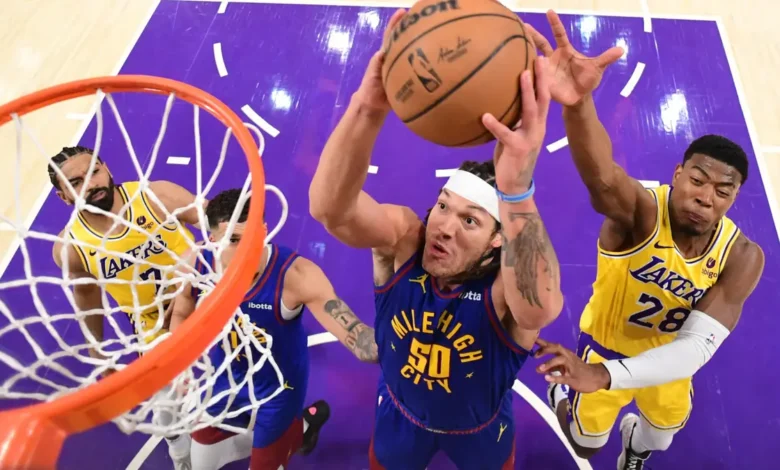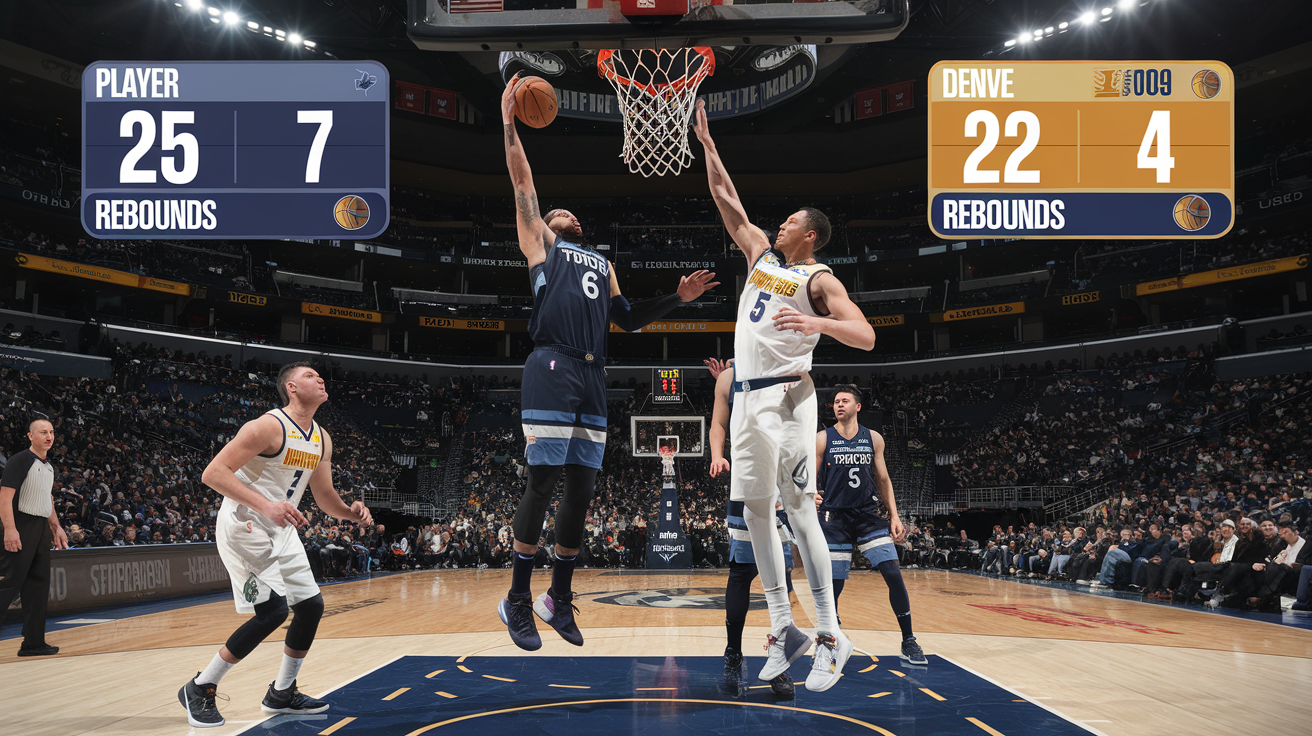Introduction
The matchup between the Denver Nuggets vs Timberwolves Match Player Stats and the Minnesota Timberwolves is one that has garnered attention due to the significance of the game’s implications in the current NBA season. As both teams vie for playoff positioning, their performance in this contest could potentially determine their trajectories moving forward. The Denver Nuggets, known for their robust offensive strategies led by their star center, Nikola Jokić, enter this game with high expectations, having demonstrated consistency throughout the season. On the other hand, the Minnesota Timberwolves have shown flashes of brilliance, driven by talents such as Anthony Edwards and Karl-Anthony Towns, which can create challenges for any opponent.
Recent game histories reveal contrasting trends; the Nuggets have been a model of stability, benefiting from the continuity of their core roster. Conversely, the Timberwolves have experienced a mix of highs and lows, often influenced by injuries and player performances. This match is critical not only for the standings but also for instilling confidence as the postseason approaches. The implications are significant; a win for the Nuggets could solidify their position among the top seeds, while a victory for the Timberwolves may enhance their playoff aspirations, allowing them to gain momentum.
Both teams have important key players to watch in this contest. For the Nuggets, the synergy between Jokić and Jamal Murray is pivotal, as they have consistently been a scoring duo capable of overwhelming opponents. The Timberwolves will rely heavily on the contributions of Edwards, whose ability to make plays and score efficiently could tilt the game in their favor. With the stakes high and both teams looking to assert their dominance, this matchup promises to be an exhilarating affair filled with intensity and drama.
Key Players to Watch

As the Denver Nuggets vs Timberwolves Match Player Stats face off, the spotlight is firmly fixed on several key players from both teams whose contributions will be instrumental in determining the game’s outcome. For the Denver Nuggets, Nikola Jokic stands out. The reigning two-time MVP has been a consistent force on the court, showcasing exceptional skills as both a scorer and a playmaker. This season, Jokic is averaging 25 points, 11 rebounds, and 8 assists per game, solidifying his status as a linchpin for the Nuggets. His ability to control the game’s pace and facilitate ball movement makes him indispensable in high-pressure situations.
On the other side, Anthony Edwards of the Timberwolves has emerged as a dynamic player to watch. With a scoring average of 24 points per game, Edwards has made significant strides in his development as a go-to scorer. His explosive athleticism and skill in creating his own shot position him as a critical element in Minnesota’s offensive strategy. Moreover, his performance in previous encounters against the Nuggets, where he has often risen to the occasion, adds an additional layer of intrigue to this matchup.
Another player of note for the Nuggets is Jamal Murray, who has recently returned from injury and is gradually finding his rhythm. His prowess as a shooter and ability to stretch the floor can create mismatches that the Timberwolves must account for. Conversely, Karl-Anthony Towns remains a cornerstone for Minnesota, combining scoring, rebounding, and versatility. His matchup against Jokic is particularly captivating, as both players possess unique skill sets that can influence the game’s dynamics.
In the context of this intense matchup, the performances of these key players will undoubtedly evoke considerable interest and could significantly sway the game’s outcome. As the game unfolds, the contributions of Jokic, Edwards, Murray, and Towns will be pivotal in shaping their respective teams’ fortunes.
First Half Player Stats

The first half of the match between the Denver Nuggets and the Minnesota Timberwolves provided a showcase of individual player performances, each contributing significantly to their team’s dynamics. These statistics reflect not only the players’ efforts but also the strategies employed by both teams during the game.
For the Denver Nuggets, standout performances were noted from key players. One notable player had an impressive scoring streak, contributing 20 points in the first half alone. This player’s shooting accuracy was commendable, hitting 75% of their attempts from the field. Additionally, they recorded three assists and grabbed five rebounds, showcasing their versatility on the court. Another team member complemented this effort with a solid defensive presence, contributing two steals and four rebounds which helped prevent the Timberwolves from gaining momentum.
Turning to the Minnesota Timberwolves, their player statistics indicated a balanced approach. One standout player scored 18 points, drawing fouls and converting a significant number of free throws, reflecting their aggressive play style. This player also demonstrated their playmaking abilities by providing four assists and securing three rebounds. Furthermore, the Timberwolves’ center played a crucial role in the paint, collecting seven rebounds, which underscored the team’s emphasis on controlling the boards.
When examining the assist-to-turnover ratios, both teams displayed commendable decision-making. The Nuggets recorded a total of eight assists against only two turnovers, indicating a strong understanding of their offensive system. In contrast, the Timberwolves managed seven assists with three turnovers, showing areas for improvement as the game progressed.
Overall, the first half player statistics from the Denver Nuggets vs Timberwolves Match Player Stats were pivotal in highlighting key individual performances that actively influenced the game’s direction. These metrics serve as a foundation for understanding how the subsequent halves might unfold, depending on adjustments made by both teams.
Second Half Player Stats

As the second half of the match commenced, both the Denver Nuggets and the Minnesota Timberwolves demonstrated strategic adjustments that significantly impacted player performance metrics. The Nuggets, initially facing challenges, recalibrated their offensive and defensive tactics, leading to an uptick in scoring efficiency. Notably, players such as Nikola Jokić and Jamal Murray took on more prominent roles, showcasing their ability to adapt under pressure. Jokić, already recognized for his versatile playmaking, continued to facilitate ball movement and create scoring opportunities, illustrated by his increased assists compared to the first half.
Meanwhile, the Timberwolves made a concerted effort to bolster their defensive presence, particularly through the efforts of Anthony Edwards and Karl-Anthony Towns. Edwards emerged as a dynamic scorer, using his agility to penetrate the Nuggets’ defense and generate high-percentage shots. His scoring not only reflected improvement but also highlighted his growth as a playmaker, as he began creating space for his teammates, leading to increased open looks. Towns, too, capitalized on his size and shooting ability, stretching the floor and posing a threat from the perimeter, which consequently opened driving lanes for others.
Key moments during the second half showcased the resilience and adaptability of both teams. The Nuggets’ execution of fast breaks and pick-and-roll situations became more effective, often resulting in layups or foul opportunities. In contrast, the Timberwolves focused on controlling the tempo, slowing down the pace to maximize shot selection. This tactical divergence led to varying contributions from bench players, with each side seeing sporadic bursts of scoring from their reserves. Overall, the second half underscored the critical role of not just starters, but also the depth of the rosters, as timely contributions proved vital in swinging the momentum of the game.
Overall Team Performance

In analyzing the performance of the Denver Nuggets and the Minnesota Timberwolves during their recent matchup, several key statistics stand out that reflect the overall strategies and effectiveness of each team. The Nuggets showcased a strong offensive approach, with a shooting percentage of approximately 48% from the field, significantly aided by their all-star players who continually found opportunities to drive to the basket or create open shots beyond the arc. This offensive efficiency was complemented by their ability to minimize turnovers, only committing 12 throughout the game, thus facilitating better ball movement and greater scoring potential.
Conversely, the Timberwolves displayed a more inconsistent offensive flow, with a shooting percentage hovering around 44%. Their strategy relied heavily on isolation plays, which ultimately limited their ability to generate assists, resulting in a total of only 15 on the night. Despite this, the Timberwolves remained competitive thanks to their aggressive rebounding, pulling down 50 boards compared to the Nuggets’ 42. This advantage on the glass allowed them to gain second-chance points which kept their scoring relevant throughout the contest.
On the defensive front, the Nuggets demonstrated notable effectiveness, making it difficult for the Timberwolves to execute their game plan. They employed a strong perimeter defense, limiting their opponents’ three-point shooting to just 32%. The Timberwolves, while having a slightly higher turnover rate at 14, managed to create pressure with their defensive stance, resulting in 8 steals. This resilience was crucial in attempting to offset the Nuggets’ scoring runs.
Ultimately, both teams displayed unique strengths and vulnerabilities throughout the match. The Nuggets thrived on their efficient shooting and low turnover rates, while the Timberwolves leveraged their rebounding and defensive pressure to keep the contest tightly contested. Each team’s performance reflected their respective strategies and adaptability, laying the groundwork for future matchups in the season.
Bench Players Impact

The contributions of bench players within the context of the Denver Nuggets vs. Minnesota Denver Nuggets vs Timberwolves Match Player Stats cannot be overlooked, as these athletes often play a crucial role in shaping the game’s dynamics. While starting lineups typically receive the lion’s share of attention, it is frequently the bench players who provide the necessary spark, allowing teams to maintain or shift momentum during pivotal moments in the game.
In this particular matchup, both teams exhibited the depth of their rosters through effective performances from their bench players. For the Nuggets, key reserves were instrumental in sustaining scoring during crucial stretches, with some players contributing double-digit points. This not only relieved starters from the burden of continuous play but also ensured that the overall intensity remained high. Moreover, these bench players were proficient in maintaining defensive pressure and facilitating smooth ball movement, laying the groundwork for scoring opportunities.
Similarly, the Timberwolves showcased their own depth, as their bench players provided valuable contributions that often changed the course of the game. Effective three-point shooting by some role players enabled the Timberwolves to narrow the gap at critical moments, emphasizing their ability to perform under pressure. These contributions amplify the significance of bench depth; having players who can step up when needed is essential for any team’s success.
The ability to rest starters without compromising the game’s intensity is a vital aspect of competitive basketball. Each bench player contributes not only through statistics but also through maintaining a rhythm that supports the starting unit. As matches progress, such depth becomes increasingly important, particularly during tightly contested moments that can dictate the ultimate outcome. Understanding the impact of bench players provides a comprehensive view of how games unfold, offering insights into strategic decisions made by coaches and the overall team dynamics on the court.
Injury Reports and Player Availability

In the context of the Denver Nuggets vs Minnesota Denver Nuggets vs Timberwolves Match Player Stats, the health and availability of key players play a crucial role in the overall dynamics of the game. Injuries can significantly influence team strategies, individual performances, and ultimately the match outcome. It is essential to monitor any reported injuries or restrictions relating to players, as they can alter the expected gameplay and statistical production.
For the Denver Nuggets, star players such as Nikola Jokić and Jamal Murray are vital to the team’s success. Any absence or limited minutes for these athletes due to injury can adversely affect the Nuggets’ offensive and defensive schemes. In previous encounters, when Jokić has been sidelined or playing with restrictions, the Nuggets have faced challenges in maintaining their momentum, leading to reliance on role players who might not perform at the same elite level. This shift can create mismatches, allowing opposing teams to exploit weaknesses.
Similarly, the Timberwolves rely heavily on the performance of their key players, including Karl-Anthony Towns and Anthony Edwards. An injury to either player could severely hinder the team’s ability to score and defend effectively. In their recent matchups, Towns’ injury history has often forced the Timberwolves to adjust their game plan, leading to an increase in dependency on bench players, which may not yield the intended results. The alteration in player availability affects the overall strategies executed during the game, making it essential to assess injury reports closely leading up to the matchup.
Thus, understanding the injury status of players for both teams is a critical component of thorough analysis when evaluating the Denver Nuggets vs Timberwolves Match Player Stats. Availability not only impacts individual stats but also the collective performance, shaping the outcomes in significant ways.
Fan Reactions and Social Media Buzz

The recent matchup between the Denver Nuggets and the Minnesota Timberwolves generated significant excitement among fans and elicited a range of reactions across social media platforms. Fans were quick to express their thoughts about individual player performances, spotlighting standout moments that defined the game. Social media was ablaze with commentary, highlighting the incredible skills exhibited by players on both teams. Nuggets’ star Nikola Jokić showcased his exceptional playmaking abilities, which drew praise from fans who flooded platforms with clips and GIFs of his impressive assists and rebounds. Similarly, Timberwolves’ Anthony Edwards, whose dynamic style of play appealed to many, ignited discussions as he scored crucial points, keeping viewers on the edge of their seats.
Twitter, Instagram, and Facebook became the avenues for fan engagement, as supporters shared their excitement and frustrations surrounding critical moments in the game. For instance, several fans quickly took to Twitter to critique a controversial call by the referees that some believed unfairly impacted the game’s outcome. This sparked a wider debate, encapsulating the passion that basketball enthusiasts hold for their teams. The hashtag #NuggetsVsTimberwolves trended as fans participated in discussions and shared their predictions, showcasing a vibrant community eager to dissect every detail of the match.
Moreover, platforms like TikTok saw a surge in creative content, with users recreating memorable scenes from the game or providing humorous takes on players’ performances. This dynamic engagement illustrates the profound connection that fans have with basketball, as they become active participants in the narrative surrounding their favorite teams. Overall, the buzz surrounding the Nuggets vs. Timberwolves game underscores the significance of player statistics and standout performances, while also reflecting the diverse and passionate voices of the basketball community. This collective dialogue emphasizes the role of social media in enhancing the fan experience and fostering an engaged sports community.
Conclusion and Future Matchups
The analysis of player statistics from the recent Denver Nuggets vs Timberwolves Match Player Stats provides significant insights into both teams’ performances and the individual developments of their key players. The Nuggets showcased their offensive prowess, with standout contributions from players like Nikola Jokić, whose all-around game continues to evolve, highlighting his ability as a playmaker and scorer. In contrast, the Timberwolves demonstrated resilience and potential, with Anthony Edwards stepping up as a pivotal player, further solidifying his status as a rising star in the league.
These statistics serve as a barometer for future matchups between these two competitive squads. The Nuggets, with their strategic depth and experience, have the advantage of entrenched talent and a cohesive system, which is evident in their impressive ball movement and defensive frameworks. Conversely, the Timberwolves are on a trajectory of improvement, bringing youth and energy, which could introduce unpredictability in their gameplay. This dynamic foreshadows a promising rivalry, where factors like player development and coaching adjustments will be instrumental in determining the outcomes of subsequent encounters. Coach Michael Malone’s strategies will need to adapt as the Timberwolves continue to mature, particularly focusing on containment techniques against their evolving offensive threats.
As the playoffs loom on the horizon, the implications of these player statistics cannot be overstated. Each matchup will not only impact standings but also provide clues regarding team strategies for the postseason. Observing how both the Nuggets and Timberwolves refine their tactics proposes an intriguing narrative for fans and analysts alike. Ultimately, the interplay of established stars and emerging talent will shape the immediate future of the Denver Nuggets and Timberwolves as they continue their pursuit of playoff success.










